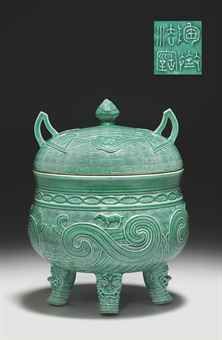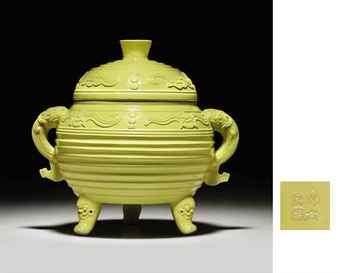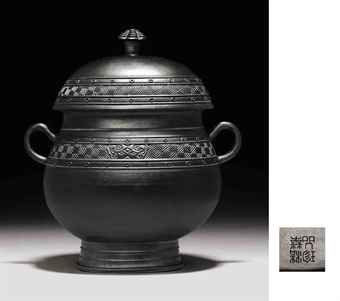A Selection of the Rende Zhai (House of Benevolent Learning) Collection of Archaistic Vessels
The Rende Zhai (House of Benevolent Learning) Collection of ceramics and works of art was carefully assembled by Dr. Olaf K. Skinsnes (1917-1997) from 1949 through the 1970s. Dr. Skinsnes was born in Henan in 1917 to parents who were medical missionaries, and after having been raised in China, moved to his parents' original home in the midwestern United States to attend university. It was during this time that he became increasingly dismayed at his fellow American's limited knowledge of China. Dr. Skinsnes not only deeply loved China, but felt that art was one of the most effective vehicles for improving mutual understanding between East and West. The Rende Zhai Collection was therefore formed as a teaching collection, used to share with those in the West the rich culture and history of China.
After completing his M.D. and Ph. D., Dr. Skinsnes intended to return to China, a wish shared by his new wife, Elizabeth Anderson Skinsnes (known as Si Anli), a nurse who had her own lifelong interest in China. However, circumstances caused the couple to relocate to Hong Kong, where they lived and worked for ten years, focusing on the study and treatment of leprosy. A man of many talents, while in Hong Kong Dr. Skinsnes designed the Diamond Hill Lutheran Church, the Yuanlong Church and the Hay Ling Chou Center for people who had leprosy. The couple subsequently returned to the United States, where Dr. Skinsnes joined the faculty of the University of Chicago. Later, in 1967, they moved to Hawaii, to help develop the University of Hawaii's John A. Burns School of Medicine, although they would continue to visit Hong Kong on an annual basis.
Although having lived all over the world, Dr. Skinsnes always longed to return to China, the land of his birth. Throughout the years, he kept in close touch with friends and colleagues in China. In 1985, his friend Dr. George Hatem (Ma Haide, 1910-1988), who had participated in the Long March, invited Dr. Skinsnes to serve as an advisor at the Sun Yat Sen University of Medical Sciences. Dr. and Mrs. Skinsnes eagerly accepted and moved to Guangzhou, where they were amongst the first Americans to be granted permanent residency. Fluent in Chinese and relishing local life, the couple veered away from the foreign settlements and moved into a smaller, local neighborhood, where they remained until 1995, when health issues forced them to return to their family in the United States. In recognition of his devotion to the country, the Chinese government awarded Dr. Skinsnes the Friendship Medal in 1992.
A Rare Green-Glazed Archaistic Four-Legged Vessel And Cover, You. Guangxu Period (1875-1908). photo Christie's Ltd 2011
The bombé body raised on four splayed legs carved with key fret below monster masks, the lower body carved on two sides with a taotie mask flanked by swooping wing-like motifs that support small figures of sheep standing in profile, all reserved on a leiwen ground below a twisted border, with a four-character mark, Tao Zhai fa bao, written in slip on the base, the domed cover with two stylized bats in flight on a leiwen ground and two openwork horn-form handles flanking a bud-form knop carved with leaves, the interior carved with a four-character inscription, Zhou tai shi Wang, the exteriors glazed green in contrast to the white-glazed interiors; 9 in. (20.8 cm.) high, wood stand, box - Estimate $20,000 - $30,000. Price Realized $80,500
Notes: The four-character inscription, Zhou tai shi Wang, may be translated as 'the Grand Preceptor Wang of Zhou.' The present vessel is modeled after the bronze Zhou tai shi Wang, illustrated in the Xuanhe bo gu tu. For a discussion of Xuanhe bo gu tu, see lot 1602. A bronze you of similar shape to the present example is in the Palace Museum collection, Beijing, and is illustrated in The Complete Collection of Treasures of the Palace Museum - 27 - Bronze Ritual Vessels and Musical Instruments. Hong Kong, 2006, pl. 127, p. 83. (Fig. 1)
A Rare Turquoise-Enameled Archaistic Vessel And Cover, Dou. Guangxu Period (1875-1908). photo Christie's Ltd 2011
With somewhat compressed globular body carved with two leiwen bands within double bow-string borders above four stylized eye motifs framed by a shaped lower border, with a pair of archaistic disc-form handles, and raised on a pedestal foot encircled by ruyi heads carved in relief, the interior of the foot with a four-character mark in relief, Tao Zhai fa bao, the domed cover with two further narrow scroll bands encircling a flower head in the center and separated by a pair of upright horn-form handles, the interior carved in a line with a four-character inscription, Han leiwen dou, the exteriors and interior of the foot covered in a soft turquoise enamel in contrast to the white interiors; 8½ in. (21.6 cm.) across handles, wood stand and box - Estimate $20,000 - $30,000. Price Realized $62,500
Notes: The four-character inscription, Han lei wen dou, may be translated as 'Han dynasty dou vessel decorated with leiwen pattern.' The four-character mark, Tao Zhai fa bao, may be translated as 'the magical weapon of Tao Zhai.' Tao Zhai is the art-name of Tao Duanfang (1861-1911), who was a senior Manchu official of the late Qing period and a renowned collector. As one of China's most preeminent antiquarians, Duanfang amassed an extraordinary collection of Chinese art, known as the Tao Zhai Collection. His passion to improve Chinese bronze studies prompted him to finance a number of technologically advanced publications, such as Taozhai jijin xulu, which was published in 1909, and was the first catalogue to use the photolithographic process to print rubbings of bronzes. Duanfang once acquired a group of twelve bronze wine vessels excavated in 1901 at Baoji county, Shaanxi province, that are now housed at the Metropolitan Museum of Art in New York.
The present vessel is modeled after the bronze Han lei wen dou illustrated in the Xuanhe bo gu tu. Commissioned by Emperor Huizong (1082-1135), Xuanhe bo gu tu was a compilation of the 839 bronze vessels from the Shang to Tang dynasty housed within the Xuanhe Palace in the Song imperial collection. The compilation began in 1107 and took more than sixteen years to complete. First grouped by type, then by chronology, the record contains a detailed drawing and description of each vessel. A bronze dou of similar shape to the present vessel, dated to the Spring and Autumn period, in the Palace Museum, Beijing, is illustrated in The Complete Collection of Treasures of the Palace Museum - 27 - Bronze Ritual Vessels and Musical Instruments,. Hong Kong, 2006, pl. 55, p. 88. (Fig. 1)
A Pinkish-Red-Enameled Archaistic Porcelain Vessel And Cover, Zun. Guangxu Period (1875-1908). photo Christie's Ltd 2011
Of archaistic bronze zun shape, the compressed globular body raised on a splayed foot encircled by a twisted chevron border, the shoulder carved with a band of archaistic elements further repeated on the domed cover with everted finial, the interior of the foot inscribed with a twenty-character inscription framed within a rectangular panel, the interior of the cover carved in a line with a four-character inscription reading Shang xiong Ding zun (zun of elder brother Ding); 8¾ in. (22.2 cm.) high - Estimate $10,000 - $15,000. Price Realized $56,250
Notes: The current vessel was modeled after a zun vessel of the same name illustrated in the Xuanhe bo gu tu. For a discussion on Xuanhe bo gu tu (Fig 1.), see lot 1602. The Shang xiong Ding zun recorded in Xuanhe bo gu tu has a handle that has not been reproduced on the current vessel, and it has the same four-character inscription on its cover and on its base reading xiong Ding da X (elder brother Ding), revealing that the vessel was cast by Ding's younger brother. The vessel was thus interpreted to have been either cast by Tai Geng, the seventh ruler of the Shang dynasty for his elder brother Wo Ding, the sixth ruler of the dynasty, or Wai Ren, the twelfth ruler, for his elder brother Zhong Ding, the eleventh ruler.
A Yellow-Enameled Archaistic Tripod Ritual Vessel And Cover, Ding. Guangxu Period (1875-1908). photo Christie's Ltd 2011
The globular body raised on three mask and paw supports and horizontally ribbed below a band of archaistic motifs interrupted by the pair of curved dragon-form handles, the base with a four-character mark, Tao Zhai fa bao, written in slip, the domed cover decorated en suite below the flared collar-form finial, the interior with a four-character inscription, Zhou Ci gong dun, carved in a line through white slip and covered with a clear glaze as is the interior of the vessel, the exterior covered overall in bright lemon-yellow enamel; 8¾ in. (22.2 cm.) high - Estimate $8,000 - $12,000. Price Realized $52,500
Notes: The four-character inscription, Zhou Ci gong dun, may be translated as, 'dun vessel of Duke Ci of Zhou.' A gui vessel of similar shape and decoration to the present vessel is in the Palace Museum collection, Beijing, illustrated in The Complete Collection of Treasures of the Palace Museum - 27 - Bronze Ritual Vessels and Musical Instruments,. Hong Kong, 2006, pl. 39, p. 64. The four-character mark, Tao Zhai fa bao, may be translated as, 'the magical weapon of Tao Zhai'. Tao Zhai is the art-name of Tao Duanfang (1861-1911). For a discussion of Duanfang, see lot 1602.
A Blue-Glazed Archaistic Stem Bowl And Cover, Dou. Daoguang Seal Marks In Relief And Of The Period (1821-1850). photo Christie's Ltd 2011
The shape based on Eastern Zhou dynasty bronze dou, the deep bowl with upright sides raised on a spreading stem encircled by a raised collar, and the domed cover surmounted by a double ropetwist loop handle, both subtly decorated in faint raised relief with archaistic patterns and covered inside and out with a soft sacrificial blue glaze that covers the slip-written seal marks inside the foot and the cover; 9¼ in. (23.5 cm.) high, wood stand, box Estimate $30,000 - $50,000. Price Realized $50,000
Notes: See another blue-glazed dou in the Victoria and Albert Museum illustrated by M. Medley, 'The Illustrated Regulations for Ceremonial Paraphernalia of the Ch'ing Dynasty', T.O.C.S., vol. 31, 1957-1959, pp. 95-105, pl. 39a. Medley notes, p. 100, that in the Winter Solstice sacrifice to Heaven in 1748, blue porcelain vessels were used for the first time as stipulated by Emperor Qianlong, and these sacrificial rites continued throughout the Qing dynasty. See, also, the similar blue-glazed Qianlong-marked dou sold in our Hong Kong rooms, 7 July 2003, lot 609.
A Pale Lime-Green-Enameled Archaistic Four-Legged Vessel And Cover. Guangxu Period (1875-1908). photo Christie's Ltd 2011
Of oblong section, the deep sides horizontally ribbed below a band of leiwen, with a pair of angular handles and raised on four cabriole legs, the base with a four-character mark, Tao Zhai fa bao, written in slip, the cover with canted sides carved with a further leiwen band and with four tapering posts rising from a ribbed border that act as legs when the cover is inverted, the interior carved with a four-character inscription, Zhou jing shu gui, the exteriors covered in pale lime-green enamel in contrast to the white interiors; 9 in. (23 cm.) across handles, wood stand, box - Estimate $12,000 - $18,000. Price Realized $46,250
Notes: A bronze gui vessel with similar decoration and shape in the Palace Museum collection, Beijing, is illustrated in The Complete Collection of Treasures of the Palace Museum - 27 - Bronze Ritual Vessels and Musical Instruments, Hong Kong, 2006, pl. 44, p. 72 The four-character mark, Tao Zhai fa bao, may be translated as 'the magical weapon of Tao Zhai'. Tao Zhai is the art-name of Tao Duanfang (1861-1911). For a discussion of Duanfang, see lot 1603.
A Rare Turquoise And Teadust-Glazed Archaistic Bell, Zhong. 19th Century.
Molded on two sides with a trapezoidal panel with inscription in relief, one panel with a three-character inscription reading huang zhong qing, the other with a two-character inscription reading da he, the panels flanked by rows of coil motifs alternating with bands of dragon-head-form clouds repeated on the rounded shoulder, all above a taotie-mask, the top with further dragon-head-form clouds surmounted by a handle formed by two confronted dragons; 10¾ in. (27.3 cm.) high, wood stand - Estimate $30,000 - $50,000. Price Realized $43,750
Notes: The present bell was modeled after a bronze prototype that was part of the Da Cheng bianzhong, or ritual bells that were commissioned by the Song dynasty emperor Huizong (1082-1135) between 1104-1105. The bells were based on the Duke Cheng of Song zhong of the Spring and Autumn period, excavated in 1104. A total of twelve sets of bells were cast, each comprising 28 bells, although only about ten or so Da Cheng bells remain today. There is one with the same inscription as the present bell in the Palace Museum, Beijing, illustrated in the The Complete Collection of Treasures of the Palace Museum - 28 - Bronze Articles for Daily Life,. Hong Kong, 2006, p. 217. (Fig. 1)
A Rare Black-Glazed Archaistic Footed Vessel And Cover, You. Guangxu Period (1875-1908). photo Christie's Ltd 2011
Of oval section and raised on a pedestal foot, the deep body carved below the rim with an archaistic 'leiwen' band between narrow borders of circles interrupted by a pair of loop handles, with a further leiwen band on the domed cover below a segmented hexagonal knop finial, the interior of the cover carved with a four-character inscription, Shang mu yi you, the interior of the foot carved with a four-character mark, qing hua zhen pin, the exterior and interior of the foot covered with a black matte glaze in contrast to the white interiors. 9¾ in. (24.8 cm.) high - Estimate $8,000 - $10,000. Price Realized $18,750
Notes:The inscription carved in a line inside the cover, Shang mu yi you, may be translated as, 'you made for mother Yi of Shang', and the four-character inscription carved on the base, qing hua zhen pin, may be translated as, 'precious object of splendor'.
The present vessel is modeled after the bronze vessel of the same name illustrated in the Xuanhe bo gu tu. (Fig. 1) For a discussion on Xuanhe bo gu tu, see lot 1603.
Christie's. Fine Chinese Ceramics and Works of Art Part I & II, 15 - 16 September 2011. New York, Rockefeller Plaza. www.christies.com

/https%3A%2F%2Fprofilepics.canalblog.com%2Fprofilepics%2F1%2F0%2F100183.jpg)
/https%3A%2F%2Fstorage.canalblog.com%2F03%2F02%2F119589%2F96711876_o.jpg)
/https%3A%2F%2Fstorage.canalblog.com%2F11%2F31%2F119589%2F94773502_o.jpg)
/https%3A%2F%2Fstorage.canalblog.com%2F20%2F83%2F119589%2F94772815_o.jpg)
/https%3A%2F%2Fstorage.canalblog.com%2F26%2F72%2F119589%2F75604929_o.jpg)
/https%3A%2F%2Fstorage.canalblog.com%2F59%2F60%2F119589%2F26458628_o.jpg)










/http%3A%2F%2Fstorage.canalblog.com%2F10%2F35%2F119589%2F113035845_o.jpeg)
/http%3A%2F%2Fstorage.canalblog.com%2F16%2F29%2F119589%2F96751956_o.jpg)
/http%3A%2F%2Fstorage.canalblog.com%2F00%2F34%2F119589%2F91698991_o.jpg)
/http%3A%2F%2Fstorage.canalblog.com%2F56%2F08%2F119589%2F91698848_o.jpg)